Danny Phillips is the second in the CFPO film series. Today, we make our way into the heart of Cadgwith cove where fishermen rely on each other to keep 16th century fishing traditions alive. Cadgwith should figure on anyone's Lizard itinerary - an eclectic mix of centuries old cove working practices woven together by cliff paths, a boat-strewn beach and superbly run pub in the form of the Cadgwith Arms.
-----------------------------------------------Merry Xmas and all the best for 2025!----------------------------------------
Showing posts with label video. Show all posts
Showing posts with label video. Show all posts
Monday, 5 November 2018
CFPO video number two - Cadgwith Cove's ever-smiling Danny Phillips tells all.
Danny Phillips is the second in the CFPO film series. Today, we make our way into the heart of Cadgwith cove where fishermen rely on each other to keep 16th century fishing traditions alive. Cadgwith should figure on anyone's Lizard itinerary - an eclectic mix of centuries old cove working practices woven together by cliff paths, a boat-strewn beach and superbly run pub in the form of the Cadgwith Arms.
Labels:
CFPO,
cove,
sustainable fishing,
video
Thursday, 1 November 2018
Seafood is the way forward - latest video from Seafish.
At Seafish we know that seafood is the way forward for business, the way forward for our communities, the way forward for the environment and the way forward for our personal health and wellbeing.
This film showcases the whole seafood industry from catch to plate; celebrating the many heroes of the seafood industry and the wonderful seafood available in the UK.
This film showcases the whole seafood industry from catch to plate; celebrating the many heroes of the seafood industry and the wonderful seafood available in the UK.
Tuesday, 16 October 2018
CFPO launches a new film series on fishing in Cornwall!
This Autumn, the CFP are launching an exciting new film series. There's a new film each week - sharing stories of fish and people around Cornwall, and showcasing the CFPO community on land and at sea.
Join us for a journey around the Cornish coast, to meet the people that catch some of the UK's most sustainable seafood.
Stay tuned, the full series of videos will be launched from the 29th of October.
Join us for a journey around the Cornish coast, to meet the people that catch some of the UK's most sustainable seafood.
Stay tuned, the full series of videos will be launched from the 29th of October.
Labels:
CFPO,
Cornish fishing,
video
Saturday, 6 October 2018
Fish recognition challenge.
Not for the first time Australian fisheries technology is leading the way in providing the latest technology to collect and collate fishing data in order to protect the livelihoods of fishermen and fish stocks.
Wanda in training for fish recognition challenge
The automated identification of harvested fish could improve confidence in the fishing sector and reduce the cost of surveillance
The use of artificial intelligence (AI) is coming to the Australian fisheries sector in the form of new software that can identify which fish are being landed on board a vessel based on video from electronic monitoring.
Called ‘Wanda’, the program uses advanced mathematical and computing techniques such as deep learning – a subset of AI – to automatically detect and identify fish species.
Wanda is the product of a CSIRO research collaboration between its Oceans and Atmosphere and Data61 divisions, with the Australian Fisheries Management Authority (AFMA) providing imagery to train the new software.
CSIRO fisheries scientist Rich Little says the software has so far been trained to recognise several species, including Yellowfin Tuna, with about 85 per cent accuracy. But with access to more images to help train Wanda, he anticipates this will increase to more than 90 per cent accuracy.
The development of Wanda began in 2016 when CSIRO Oceans and Atmosphere fisheries scientists Rich Little, Geoff Tuck and Rob Campbell teamed with CSIRO Data61’s Dadong Wang to explore the potential of a machine-learning product for species identification in fisheries.
In demand
Currently, electronic monitoring imagery is reviewed by people who identify different fish species. “But we realised this was a constraint on the current technology, and discovered there was a very large need nationally and internationally for our new program to automatically identify fish species and to remove this human element,” Rich Little says.
“As a commercial product the market is quite small; the most likely customers are typically regulatory agencies and resource managers.”
However, the potential application of the technology continues to expand as more countries introduce on-board electronic monitoring in their fisheries. Wanda sits amongst a cohort of similar initiatives being developed around the world, including those led by the UN’s Food and Agriculture Organization and another led by Queensland’s Department of Agriculture and Fisheries.
In Australia, AFMA has mandatory electronic monitoring on 75 vessels operating in the Eastern Tuna and Billfish Fishery, the Western Tuna and Billfish Fishery and the Gillnet, Hook and Trap Fishery. Electronic monitoring technology potentially offers a cost-effective alternative to aspects of the human on-board observer programs that still operate in many fisheries.
Human observers are required to monitor a certain percentage of activity in various fisheries to meet assessment targets and enable effective data analysis. This can vary greatly – anywhere from five to almost 100 per cent of activity, depending on the fishery and what observers are looking for, with an average of about 10 per cent.
Likewise, only a small proportion (usually 10 per cent) of the thousands of hours of video collected by electronic monitoring is actually reviewed. The reasons for this vary; for example, only a small percentage of footage actually captures fishing activity. However, AI has a real potential to streamline and reduce the reviewing costs, while increasing the amount of video actually reviewed.
There is potential for electronic monitoring to be used in other Australian Commonwealth and state fisheries. It has also recently become mandatory in some New Zealand and Chilean fisheries.
“It’s a growing trend, worldwide,” Rich Little says. “And with the right training, Wanda will be able to assess all of the available video, rather than a small fraction. We think we will be able to help further reduce the costs of monitoring through the automatic identification of species.”
Transparency
While species identification features will begin with target catch species, it is likely to expand to byproduct and bycatch species as well as threatened, endangered and protected species.
Rich Little says increasing the amount of fishing time actually scrutinised has the potential to significantly increase public confidence in the fisheries sector. From both a management and an industry perspective, it will provide greater evidence of compliance – that fishers are doing the right thing, and are known to be doing so.
From the initial concept, when it came to developing the software Rich Little and Geoff Tuck joined with Dadong Wang at Data61 for expertise in the computer vision and machine learning processes.
Initial video training has used test data from AFMA, but really requires thousands of images all up. But it’s not just a matter of identifying a fish. The program needs to be able to identify where in each frame the fish is – often as it is sliding across the deck of a working fishing boat.
In the early stages of training, this means someone needs to find the fish and graphically put a binding box around it so that Wanda can ‘learn’ where the fish is and what it looks like.
The more images used in training, the more accurate the results. While imaging technology continues to make huge gains, the sophistication required to distinguish certain species is likely to make it impossible for wholesale use.
Recognising the long-term savings available to industry of this technology, AFMA is keen to work with CSIRO to provide access to imagery from its Eastern Tuna and Billfish Fishery (ETBF), which has the longest and most extensive video dataset in Commonwealth fisheries.
“As the ETBF is a longline fishery, it generally brings fish on board one at a time – unlike a trawl fishery – and this will make training and identification easier,” Rich Little says. Swordish, and Yellowfin, Albacore and Big Eye Tuna are likely to be the focus of the initial AFMA case study designed to demonstrate Wanda’s effectiveness.
A postdoctoral researcher will be employed as part of a three-year project to refine Wanda. But with the new dataset, Rich Little says results with high accuracy could be achievable in six to eight months.
Significant issues of bycatch, biosecurity and environmental benefits are being addressed through new technology that gives trawl-net fishers ‘eyes in the net’.
While camera technology is becoming an essential part of on-board monitoring for fisheries compliance, it is also being applied to improve the efficiency of trawl fishing.
DigiCatch is the name of a new ‘precision fishing technology’ developed by US company SmartCatch. CEO Mark Dahm presented at last year’s Seafood Directions conference, saying the system has provided a two per cent reduction in bycatch for some users, which could be worth up to $100,000 to a trawl business. It provides ‘eyes in the net’ via real-time, high-definition video that allows fishers to see what they are capturing – at depths of more than 900 metres – before the catch is landed on deck.
Combined with another SmartCatch innovation, SmartNet, fishers can release non-target species from the net underwater through a pre-catch release system. Mark Dahm said it allowed fishers to maximise catches of target species within quota, while avoiding non-target species that could lead to fines or potential fishery closures.
Additional digital sensors also convey information about salinity, depth, location and acidity – information that is vital for biosecurity and traceability, which is becoming increasingly important in seafood markets as consumers demand detail on seafood origin.
Mark Dahm, whose background in technology includes more than 25 years working in Silicon Valley, in the US, said it was his passion for the sea that led him to apply his technology skills to the fishing industry.
The DigiCatch technology was voted the Gold Winner for Innovation in Sustainable Solutions in the 2016 Edison Awards and is being used by some major players in the North American seafood industry fishing in the Bering Sea.
While the technology has initially been expensive, costing about US$40,000 (A$53,7500) a system, Mark Dahm said the price was fast coming down and could be retrofitted to existing gear. Eventually, he said, the system could become cost-neutral as the data recorded by the technology builds and becomes more valuable.
“Data is the oil of our time and we believe the major commercial seafood companies, the government agencies and fishery councils will pay for that data and subsidise these devices on the boats so it becomes standard practice,” he said.
The technology could help sustain the fishing sector as well as fish stocks, helping fishers comply with regulations while providing consumers with the sustainable seafood they sought.
“We start right here with what begins with DigiCatch in the net capturing data at the point of capture ... and ultimately it’s about a great piece of protein on the plate,” he said. Mark Dahm said Smartcatch delivered on a triple-bottom-line objective to bring economic, ecological and social benefits.
“There is huge economic impact in being able to bring this type of technology to the seafood industry; there is the ecological component of building sustainable ocean technology to save our fish species and make our supply chain more efficient; and then there’s the social and the food security aspect ... and as we know, seafood is really good for us.”
More information and the full story from FRDC.
Labels:
fish recognition,
IT,
technology,
video
Thursday, 19 October 2017
Atlantic cod - seeing is believing!
Atlantic cod, New England’s most iconic fish, has been reported at historic lows for years, but fishermen hope a new video monitoring technique will prove there are more of the fish than federal surveyors believe.
Ronnie Borjeson, who has been fishing for more than 40 years, says the federal surveys don’t match up with what fishermen are seeing. “I don’t care if you’re a gillnetter, a hook and line guy, a trawl guy,” he said, “there’s codfish everywhere up there. Everywhere. You can’t get away from them.”
Borjeson helped test a video rig designed by researchers at the University of Massachusetts Dartmouth that allows them to record fish underwater and count them on the video later. With this rig, scientists can sample a larger area in the same amount of time and hopefully improve federal estimates of how many cod are left.
For years, Atlantic cod has been reportedly overfished—but a new video monitoring technique may prove otherwise.
According to the National Marine Fisheries Service, cod are overfished, and in 2014, the spawning population reached its lowest numbers ever recorded. The once-booming cod fishery has been subject to increasingly strict regulations since the 1990s, forcing commercial fishermen to target less-profitable species while they wait for the cod population to recover.
Kevin Stokesbury, the researcher spearheading the project, hoped to create a more effective and transparent monitoring system by collaborating with local fishermen. “They know their gear and they know the distributions. So for me, I’ve certainly never discounted what they say,” he said. “You have to back that up scientifically, and I think that this is a means to do that.”
Federal scientists estimate the cod population by towing nets through randomly selected areas of the fishing grounds and hauling the fish on board to be counted. The results of these trawls are combined with information from fisheries observers and catch estimates to create a picture of the overall health of the fishery.
But cod are not evenly distributed across the ocean floor. The fish gather in tight groups to spawn, leaving large areas of habitat essentially devoid of cod and increasing the likelihood that a random sample will come up empty. The federally managed area in the Gulf of Maine alone is more than 30,000 square miles. With limited time and resources to accomplish their work, federal surveyors must rely on a small number of these surveys to accurately estimate the whole population.
And, according to Borjeson, “The general consensus [among fishermen] is they’re incapable of catching fish.”
Yet as Jon Hare, the Science and Research Director for NOAA’s Northeast Fisheries Science Center pointed out, fishermen “are targeting and looking for higher abundances of cod. That could also make their perspective on the abundance of cod different than what’s coming out of the [survey].”
Stokesbury thinks his video system can, at the very least, help scientists get a better idea of how many fish are in the spawning groups and help the fishery managers and fishermen see eye to eye.
The video rig has gone through several iterations to deliver clear images in the harsh, salty environment. The current version has two cameras and a set of LED lights facing backwards inside a fishing net. When fish are swept into the net, they pass the cameras and are funneled harmlessly out the open back end.
Hare agreed that the system holds promise, but cautioned that the work is not yet done. “You still need to extract [the information] from the video. You’re potentially looking at thousands of hours of video data,” he said.
Stokesbury and his team are working on this problem now. Currently the software takes two to three weeks to identify and count the fish for every week at sea. This is a vast improvement over the original method–graduate students counting by hand–but Stokesbury expects to reduce the processing time further as their software improves.
If that happens, Hare believes the system could be very useful. “As humans, we put a lot of faith in visual data,” he said, “Having the real-time visual information is a good approach to having people come to a common understanding.”
Borjeson hopes fisheries managers will incorporate video monitoring as soon as possible. “The system works,” he said. “People love it. They embrace it. It’s absolutely indisputably the way to do a stock assessment.”
Full story courtesy of NovaNet.
Ronnie Borjeson, who has been fishing for more than 40 years, says the federal surveys don’t match up with what fishermen are seeing. “I don’t care if you’re a gillnetter, a hook and line guy, a trawl guy,” he said, “there’s codfish everywhere up there. Everywhere. You can’t get away from them.”
Borjeson helped test a video rig designed by researchers at the University of Massachusetts Dartmouth that allows them to record fish underwater and count them on the video later. With this rig, scientists can sample a larger area in the same amount of time and hopefully improve federal estimates of how many cod are left.
For years, Atlantic cod has been reportedly overfished—but a new video monitoring technique may prove otherwise.
According to the National Marine Fisheries Service, cod are overfished, and in 2014, the spawning population reached its lowest numbers ever recorded. The once-booming cod fishery has been subject to increasingly strict regulations since the 1990s, forcing commercial fishermen to target less-profitable species while they wait for the cod population to recover.
Kevin Stokesbury, the researcher spearheading the project, hoped to create a more effective and transparent monitoring system by collaborating with local fishermen. “They know their gear and they know the distributions. So for me, I’ve certainly never discounted what they say,” he said. “You have to back that up scientifically, and I think that this is a means to do that.”
Federal scientists estimate the cod population by towing nets through randomly selected areas of the fishing grounds and hauling the fish on board to be counted. The results of these trawls are combined with information from fisheries observers and catch estimates to create a picture of the overall health of the fishery.
But cod are not evenly distributed across the ocean floor. The fish gather in tight groups to spawn, leaving large areas of habitat essentially devoid of cod and increasing the likelihood that a random sample will come up empty. The federally managed area in the Gulf of Maine alone is more than 30,000 square miles. With limited time and resources to accomplish their work, federal surveyors must rely on a small number of these surveys to accurately estimate the whole population.
And, according to Borjeson, “The general consensus [among fishermen] is they’re incapable of catching fish.”
Yet as Jon Hare, the Science and Research Director for NOAA’s Northeast Fisheries Science Center pointed out, fishermen “are targeting and looking for higher abundances of cod. That could also make their perspective on the abundance of cod different than what’s coming out of the [survey].”
Stokesbury thinks his video system can, at the very least, help scientists get a better idea of how many fish are in the spawning groups and help the fishery managers and fishermen see eye to eye.
The video rig has gone through several iterations to deliver clear images in the harsh, salty environment. The current version has two cameras and a set of LED lights facing backwards inside a fishing net. When fish are swept into the net, they pass the cameras and are funneled harmlessly out the open back end.
Hare agreed that the system holds promise, but cautioned that the work is not yet done. “You still need to extract [the information] from the video. You’re potentially looking at thousands of hours of video data,” he said.
Stokesbury and his team are working on this problem now. Currently the software takes two to three weeks to identify and count the fish for every week at sea. This is a vast improvement over the original method–graduate students counting by hand–but Stokesbury expects to reduce the processing time further as their software improves.
If that happens, Hare believes the system could be very useful. “As humans, we put a lot of faith in visual data,” he said, “Having the real-time visual information is a good approach to having people come to a common understanding.”
Borjeson hopes fisheries managers will incorporate video monitoring as soon as possible. “The system works,” he said. “People love it. They embrace it. It’s absolutely indisputably the way to do a stock assessment.”
Full story courtesy of NovaNet.
NOVA Next is NOVA’s award-winning digital publication that provides answers from the cutting edge of science and technology. Launched in 2012, we feature in-depth articles and commentaries from some of the most respected journalists, scientists, and engineers. NOVA Next explores the ideas that are changing the future, from the frontiers of synthetic biology to the politics of personalized medicine.
If you’re a journalist and have an idea for a story, send it our way.
Labels:
fishing,
surveillance,
USA,
video
Wednesday, 10 May 2017
Fishing from Newlyn video.
Falmouth University student Adam Pickup-Bowker has put together an insightful video on the fishing industry as he sees it in Newlyn. Even more reassuring is the sight of a young skipper, James Roberts and his even younger crew, William - an inspiration if ever there was that fishing has a future - these guys believe it!
Tuesday, 9 October 2007
New St Ives boat makes good news for Newlyn
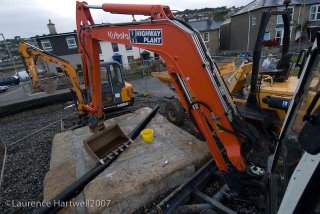
With only a couple of days to go work continues on the fisherman's memorial....
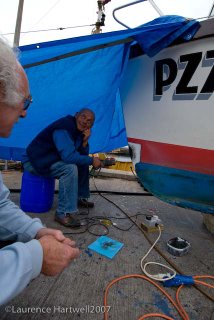
more hot air in Newlyn, this time some repairs to the bow after a shock collision off Mousehole Island this morning - and the submerged object hit? - remains a mystery - and no, it wasn't a floating rock as some wit suggested!
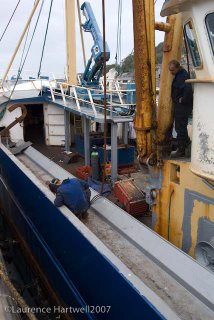
the Jacoba's new scallop handling gear is nearly complete....
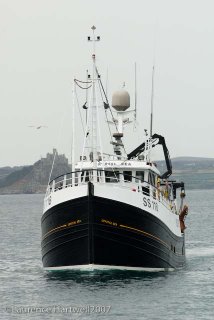
at 3pm, the first big whitefish trawler for the port since the Dumnonia in 1988 and the first Steven's family boast since the newly built Rose of Sharon in 1968...
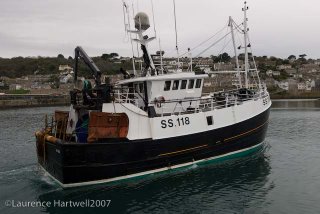
and steams up the harbour to the fish market....
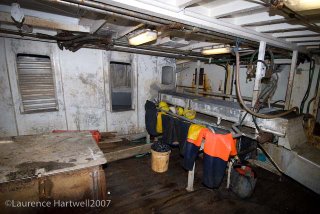 a view of her fish handling gear starboard side...
a view of her fish handling gear starboard side...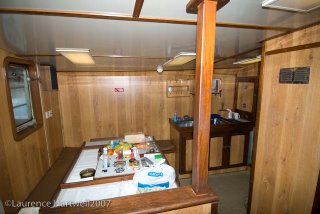
a spacious starboard side mess will keep her crew happy at mealtimes....
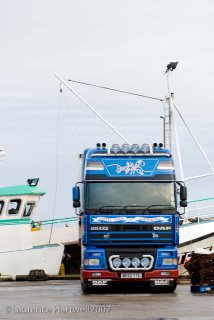
meanwhile, down the end of the new quay the Intuition is landing her shellfish to a waiting lorry...
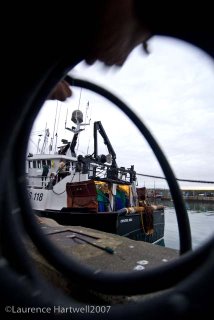
through the eye of the water hose....
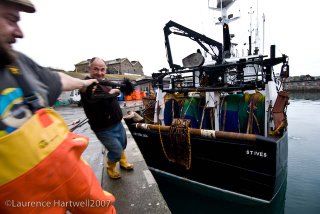
SS118 Crystal Sea takes 7 tons of best Newlyn Ice Company frozen water, flaked of course!
Labels:
video
Subscribe to:
Posts (Atom)
